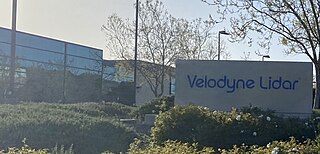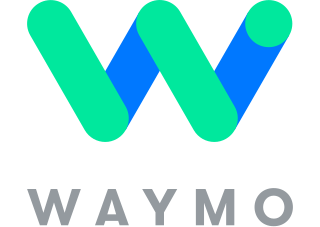
A self-driving car, also known as an autonomous car (AC), driverless car, robotaxi, robotic car or robo-car, is a car that is capable of operating with reduced or no human input. Self-driving cars are responsible for all driving activities, such as perceiving the environment, monitoring important systems, and controlling the vehicle, which includes navigating from origin to destination.

Simultaneous localization and mapping (SLAM) is the computational problem of constructing or updating a map of an unknown environment while simultaneously keeping track of an agent's location within it. While this initially appears to be a chicken or the egg problem, there are several algorithms known to solve it in, at least approximately, tractable time for certain environments. Popular approximate solution methods include the particle filter, extended Kalman filter, covariance intersection, and GraphSLAM. SLAM algorithms are based on concepts in computational geometry and computer vision, and are used in robot navigation, robotic mapping and odometry for virtual reality or augmented reality.

A multi-agent system is a computerized system composed of multiple interacting intelligent agents. Multi-agent systems can solve problems that are difficult or impossible for an individual agent or a monolithic system to solve. Intelligence may include methodic, functional, procedural approaches, algorithmic search or reinforcement learning.

Sebastian Thrun is a German-American entrepreneur, educator, and computer scientist. He is CEO of Kitty Hawk Corporation, and chairman and co-founder of Udacity. Before that, he was a Google VP and Fellow, a Professor of Computer Science at Stanford University, and before that at Carnegie Mellon University. At Google, he founded Google X and Google's self-driving car team. He is also an adjunct professor at Stanford University and at Georgia Tech.

Velodyne Lidar is a Silicon Valley-based lidar technology company, headquartered in San Jose, California. It was spun off from Velodyne Acoustics in 2016. As of July 2020, the company has had about 300 customers. Velodyne Lidar ships sensors to mobility industry customers for testing and commercial use in autonomous vehicles, advanced driver assistance systems, mapping, robotics, infrastructure and smart city applications. In February 2023, the company merged with Ouster.

Waymo LLC, formerly known as the Google Self-Driving Car Project, is an American autonomous driving technology company headquartered in Mountain View, California. It is a subsidiary of Alphabet Inc, the parent company of Google.

X Development LLC, doing business as X, is an American semi-secret research and development facility and organization founded by Google in January 2010. X has its headquarters about a mile and a half from Alphabet's corporate headquarters, the Googleplex, in Mountain View, California.

Experiments have been conducted on self-driving cars since 1939; promising trials took place in the 1950s and work has proceeded since then. The first self-sufficient and truly autonomous cars appeared in the 1980s, with Carnegie Mellon University's Navlab and ALV projects in 1984 and Mercedes-Benz and Bundeswehr University Munich's Eureka Prometheus Project in 1987. Since then, numerous major companies and research organizations have developed working autonomous vehicles including Mercedes-Benz, General Motors, Continental Automotive Systems, Autoliv Inc., Bosch, Nissan, Toyota, Audi, Volvo, Vislab from University of Parma, Oxford University and Google. In July 2013, Vislab demonstrated BRAiVE, a vehicle that moved autonomously on a mixed traffic route open to public traffic.
A robotaxi, also known as robot taxi, robo-taxi, self-driving taxi or driverless taxi, is an autonomous car operated for a ridesharing company.

Anthony Levandowski is a French-American self-driving car engineer. In 2009, Levandowski co-founded Google's self-driving car program, now known as Waymo, and was a technical lead until 2016. In 2016, he co-founded and sold Otto, an autonomous trucking company, to Uber Technologies. In 2018, he co-founded the autonomous trucking company Pronto; the first self-driving technology company to complete a cross-country drive in an autonomous vehicle in October 2018. At the 2019 AV Summit hosted by The Information, Levandowski remarked that a fundamental breakthrough in artificial intelligence is needed to move autonomous vehicle technology forward.

John F. Krafcik was the CEO of Waymo from 2015 to 2021. Krafcik was the former president of TrueCar and president and CEO of Hyundai Motor America. He was named CEO of Google's self-driving car project in September 2015. Krafcik remained CEO after Google separated its self-driving car project and transitioned it into a new company called Waymo, housed under Google's parent company Alphabet Inc.

Chris Urmson is a Canadian engineer, academic, and entrepreneur known for his work on self-driving car technology. He cofounded Aurora Innovation, a company developing self-driving technology, in 2017 and serves as its CEO. Urmson was instrumental in pioneering and advancing the development of self-driving vehicles since the early 2000s.
Cruise LLC is an American self-driving car company headquartered in San Francisco, California. Founded in 2013 by Kyle Vogt and Dan Kan, Cruise tests and develops autonomous car technology. The company is a largely autonomous subsidiary of General Motors. Following a series of incidents, it suspended operations in October 2023, and Kyle Vogt resigned as CEO in November 2023.
David Stavens is an American entrepreneur and scientist. He was co-founder and CEO of Udacity; a co-creator of Stanley, the winning self-driving car of the DARPA Grand Challenge; and co-founder and CEO of Nines, a creator of AI-enabled FDA-approved medical devices. Stavens has published in the fields of robotics, machine learning, and artificial intelligence and has helped start organizations with an aggregate market value of over $30 billion.
Nuro, Inc. is an American robotics company based in Mountain View, California. Founded by Jiajun Zhu and Dave Ferguson, Nuro develops autonomous delivery vehicles and is the first company to receive an autonomous exemption from the National Highway Traffic Safety Administration.

Yandex self-driving car is an autonomous car project of the Russian-based technology company Yandex. The first driverless prototype launched in May 2017. As of 2018, functional service was launched in Russia with prototypes also being tested in Israel and the United States. In 2019, Yandex revealed autonomous delivery robots based on the same technology stack as the company's self-driving cars. Since 2020, autonomous robots have been delivering food, groceries and parcels in Russia and the United States. In 2020, the self-driving project was spun-off into a standalone company under the name of Yandex Self-Driving Group.
Matthew Johnson-Roberson is an American roboticist, researcher, entrepreneur and educator. Since January 2022 he has served as director of the Robotics Institute at Carnegie Mellon University. Previously he was a professor at the University of Michigan College of Engineering since 2013, where he co-directed the UM Ford Center for Autonomous Vehicles (FCAV) with Ram Vasudevan. His research focuses on computer vision and artificial intelligence, with the specific applications of autonomous underwater vehicles and self-driving cars. He is also the co-founder and CTO of Refraction AI, a company focused on providing autonomous last mile delivery.

Tekedra Mawakana is an American businesswoman and lawyer is the co-chief executive officer of Waymo. Previously, she was the company's chief operating officer, and prior employers have included Steptoe & Johnson, AOL, Yahoo!, and eBay. Mawakana has served on the boards of the Consumer Technology Association, the Global Network Initiative, the Internet Association, Boom Supersonic, Operator Collective, and Intuit.
Shaoshan Liu is a US-based computer scientist, who is also the founder, chairman and CEO of PerceptIn. Presently, he is a senior member of IEEE, a member of ACM and a member of the editorial board of IT Professional. Additionally, he is the vice chair of IEEE Computer Society's Special Technical Community on Autonomous Driving Technologies.













